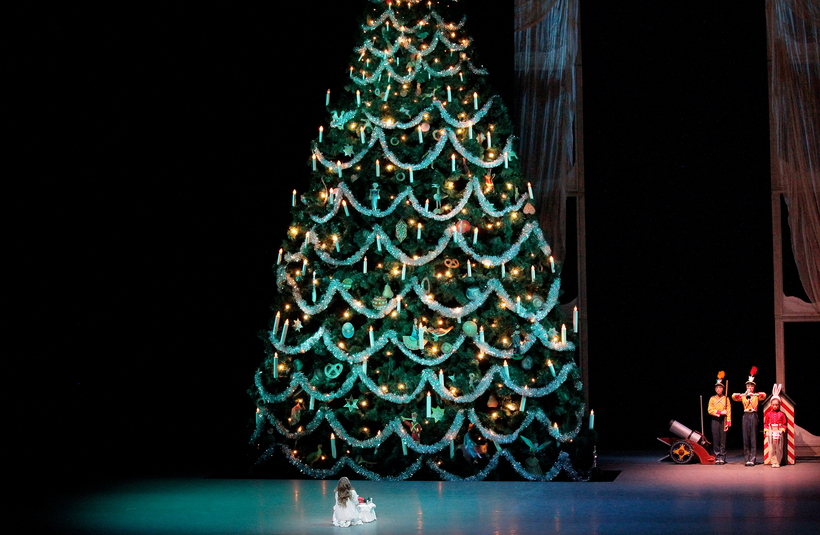“The Nutcracker,” the choreographer George Balanchine said repeatedly, ”is the tree.” The Christmas tree, of course. But what, exactly, does that mean? I’ve been a dance critic for decades, have seen countless Nutcrackers, and still I ponder the score, the scenario, and the new interpretations introduced by new stagings of the ballet. Viewed as child’s play, The Nutcracker, which premiered in 1892, is deemed a cultural toy—akin to one of Herr Drosselmeier’s magical automatons—to be enjoyed during the holidays and then put back in a cabinet. But the more you listen to it, and the more you read and think about it, the deeper the questions.
For instance, which is more sublime: the snow-laden andante that comes at the end of Act One, or the magisterial Sugar Plum adagio that crowns Act Two? The first is primal, a snow-blue bliss amid a forest of firs; the second is proudly poised, a formal statement of courtliest love; yet both have dark contours, achingly so, as if to say that all perfection is shadowed by loss. And what does the Land of Sweets represent? Children read it differently than do adults, who have another context for pleasure. And then, the tree. The Mariinsky choreographer who shaped the story for the stage, Marius Petipa, wrote in note No. 21 to the composer Pyotr Ilyich Tchaikovsky, “The Christmas tree becomes huge. 48 bars of fantastic music with a grandiose crescendo.” Yet who decided it should become huge? This is what I’ve been wondering lately.
Marius Petipa wrote, “The Christmas tree becomes huge.” Yet who decided it should become huge?
The Nutcracker is rooted in E. T. A. Hoffmann’s story of 1816, Nutcracker and Mouse King. He meant it to be a new kind of fairy tale, and all sorts of wild things happen, but one thing does not—the tree doesn’t grow. Likewise in Alexandre Dumas’s softened rewrite of Hoffmann, upon which the ballet is based—the tree doesn’t grow. Hoffmann did, however, give a bit of stage direction: inside a wardrobe, at the pull of a tassel on a fox fur coat, “a very delicate cedar stairway quickly dropped through the fur sleeve. ‘Please go up, dearest demoiselle,’ cried the Nutcracker.” So the path is upward.
Clearly, those 48 bars of “grandiose crescendo” were a theatrical imperative, a necessary invention that dramatizes the story’s rise from reality to fantasy, from a bourgeois living room to the boundless green reaches of imagination. The idea had to come from either the Mariinsky director Ivan Vsevolozhsky or from Petipa, who lays claim to the libretto. Scholars have not pinpointed one or the other, and the only scholar who actually analyzes the importance of this vital addition is Roland John Wiley, in his superb study Tchaikovsky (2009). “The motifs of the growing Christmas tree and the winter forest, missing in Hoffmann,” he writes of The Nutcracker, “echo ancient representations of the underworld, regular world, and heavenly realm being joined by a tree, as does the meaning of winter not just as a demise before rebirth but also, joined with the forest, as a path to another world, possibly the realm of the dead. Supporting this are blatant contrasts between the acts: action/stasis, day/night, house/forest, earthly/heavenly, actual/magical, life/death, passing time/eternity. All of this suggests a sophisticated subtext.”
A sophisticated subtext, indeed. Do not take The Nutcracker lightly. As you settle in your seat, think about the above-mentioned contrasts, and why it is a tree that is transformative. As for new productions to take note of, in Salt Lake City, Ballet West is bringing back the first full-length American Nutcracker, Willam Christensen’s production of 1944, created for the San Francisco Ballet; the spanking new sets and costumes cost $3 million! And the Atlanta Ballet’s “virtual reality” Nutcracker is now in its second season. Artistic director Gennadi Nedvigin pulled together a crack creative team and the result is stunning theater that takes Hoffmann very seriously. When the tree starts growing, the stage space becomes a vast celestial timepiece, gold and silver, an armillary sphere that encompasses an expanding universe—the subconscious and its shooting stars.
